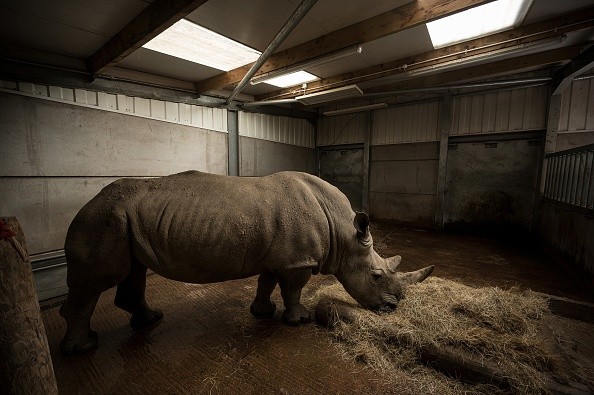Artificial insemination is now being used by the Brevard Zoo to help white rhinos avoid extinction.

(Photo : Photo by OLI SCARFF/AFP via Getty Images)
A White Rhinoceros feeds in its shelter at Knowsley Safari, near Liverpool, northern England on May 14, 2020, whilst the safari park is closed to visitors during the nationwide lockdown due to the novel coronavirus pandemic.
Although white rhinoceros are not endangered, they are already near threatened; with less than 16,000 population. Because of this, the Brevard Zoo wants to help revive the population of white rhinos.
The Florida-based zoo already used cutting-edge science tech to help two white rhinos, Kibibi and Uzuri, to reproduce.
Artificial Insemination Helps White Rhinos Avoid Extinction!
According to Spacecoast Daily, the Brevard Zoo is working with SEZARC (South-East Zoo Alliance for Reproduction and Conservation), a non-profit animal organization, as well as with Omaha's Doorly Zoo and Aquarium.

(Photo : Photo credit should read TONY KARUMBA/AFP via Getty Images)
Najin (L) and Fatu, the only two remaining female northern white rhinos graze in their paddock on March 20, 2018 at the ol-Pejeta conservancy in Nanyuki, north of capital Nairobi.
Also Read: Scientists Dissect 3,500-Year-Old Bear, Found in Siberian Permafrost as Perfectly Preserved
The artificial insemination was already done in mid-February. As of writing, the Brevard Zoo is checking the status of the two white rhinos.
However, it would take more than a month before early pregnancy stages are identified. The zoo said that they will continue to conduct ultrasounds and bloodwork to monitor the health of Kibibi and Uzuri.
Once the two white rhinos are pregnant, it would still take around 16 months before the babies come out.
Fun Facts About Rhinos
Many rhinoceros species are also being threatened because of poaching. Aside from the white rhinos, Sumatran, Indian, Black, and Javan rhinoceros are also facing declining populations.
Rhinoceros are among the most interesting animals because of their giant horns and armored-like bodies.
If you are not familiar with them, here are some fun facts about rhinos that the World Wildlife Fund provided:
- Most rhinos weigh over three tonnes.
- Black and white rhinoceros are actually grey in color.
- A group of rhinos is called a "crash."
- Rhino horns are also made up of keratin; the same protein that forms your nails and hairs.
- Rhinoceros have poor vision, making them unable to spot a motionless object at a distance of around 30 meters.
- Since rhinos have poor vision, they rely on their strong sense of smell.
- Rhinos communicate with each other through their poo, sneezes, and honks.
If you want to learn more about the rhinoceros, you can visit this link.
Other stories we recently wrote about animals:
Satellite imagery was used to find a new emperor penguin colony, which consists of 1,000 birds. We also reported about China's new super cow cloning activity.
For more news updates about rhinos and cows, always keep your tabs open here at TechTimes.
Related Article: [LOOK] World Nature Photography Awards Features the Best, Most Fascinating Wildlife Captures










